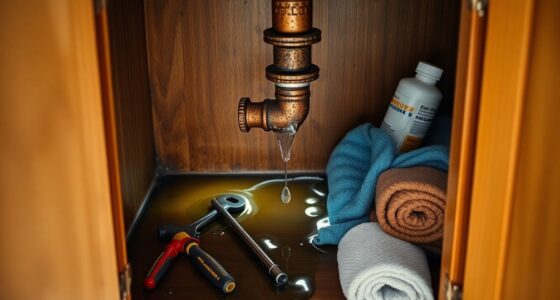To repair a sinking foundation, start by identifying warning signs like cracks in the drywall and misaligned doors. You'll need to determine the cause, which could be poor construction or soil issues. Common repair methods include installing steel or helical piers, mudjacking, or underpinning with concrete piers. It's essential to act quickly to avoid further damage. Understanding repair costs and seeking professional evaluation will help you make informed decisions. Discover effective solutions to stabilize your foundation effectively.
Key Takeaways
- Identify warning signs of a sinking foundation, such as cracks, misaligned doors, and gaps to determine the extent of damage.
- Consult a foundation repair expert for a thorough evaluation and tailored repair recommendations based on the specific issues observed.
- Consider repair methods like steel push piers or helical piers for long-term stabilization and support in various soil conditions.
- Address any water leaks promptly to prevent further structural damage and worsening foundation issues.
- Obtain multiple quotes from reputable companies to compare repair costs and ensure compliance with local building codes.
Warning Signs of a Sinking Foundation
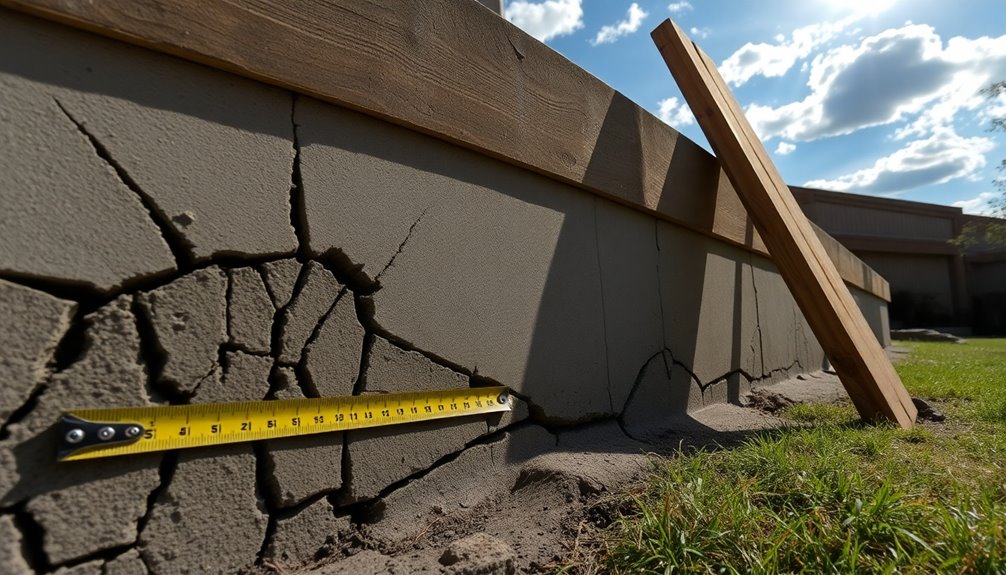
When you notice cracks in your drywall, especially if they're at 45-degree angles or wider than 1/8 inch, it's time to pay attention.
These are warning signs of potential structural issues in your home. You might also notice misaligned doors and windows that stick or don't close properly, indicating shifts in the foundation.
Leaning chimneys with noticeable gaps between them and the exterior can further suggest significant foundation movement.
Keep an eye out for gaps between walls, windows, or cabinets, as these can signal structural shifts due to a sinking foundation.
Finally, musty basements with moisture accumulation not only point to foundation problems but can also lead to mold growth and health risks.
Address these issues promptly to protect your home.
Causes of Foundation Sinking
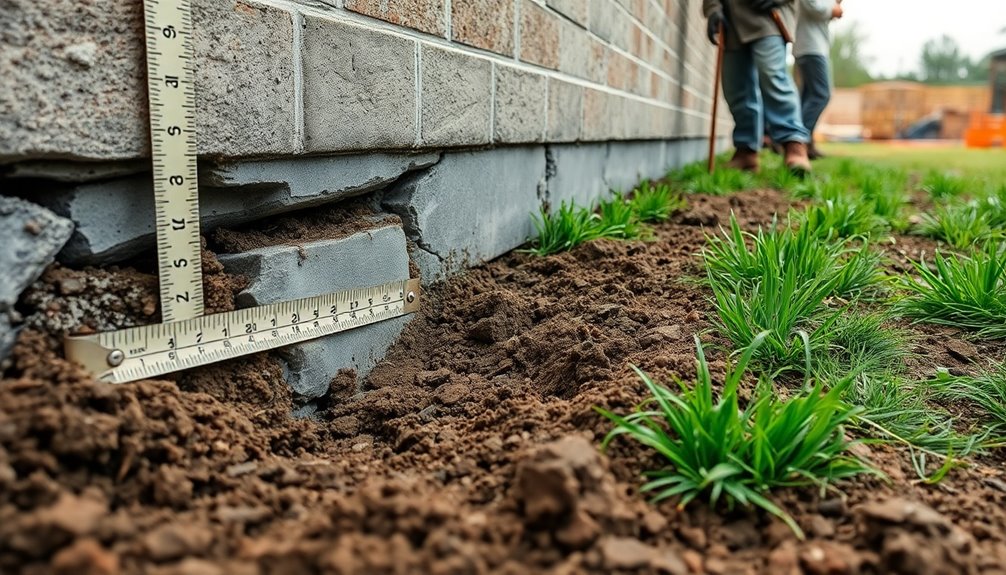
When it comes to foundation sinking, you need to take into account several key factors.
Poor construction practices can leave your home vulnerable, while weather-related issues like drought and flooding can exacerbate the problem.
Additionally, the soil composition beneath your foundation plays an essential role in its stability.
Soil Composition Issues
Soil composition issues greatly impact the stability of your foundation, especially if you have sandy or swampy soil. Unstable soil can lead to foundation settlement, requiring costly foundation repair.
Here are some common causes of foundation sinking related to soil composition:
- Poorly compacted soil during construction can create air pockets.
- Erosion from water flow can wash away supportive soil layers.
- Droughts can cause soil contraction, pulling it away from your foundation.
- Ice formations from freezing damp soil can disrupt the soil structure.
To prevent these issues, make certain you have stable soil around your home.
Regularly assess your soil's condition to avoid future foundation problems and maintain the integrity of your home.
Weather-Related Factors
Weather can greatly affect the stability of your foundation, especially during extreme conditions. Prolonged droughts lead to soil contraction, pulling dirt away from your foundation and causing it to sink.
On the flip side, heavy rains or melting snow can flood your yard, resulting in erosion that undermines the soil's support. Changes in temperature trigger freeze-thaw cycles, creating frost heaves that push your foundation out of alignment.
Additionally, erosion from water flow, particularly in poorly drained areas, can destabilize the soil around your home. Ice formations may also develop under your house, as damp soil freezes and expands, exerting pressure on the foundation and causing structural movement.
Stay vigilant about these weather-related factors to protect your home.
Poor Construction Practices
While you mightn't think about it during construction, poor practices can lead to significant foundation issues later on. These practices can create serious foundation damage, making repairs more complicated and costly.
Here are key factors to take into account:
- Inadequate soil compaction can leave air pockets, causing instability.
- Ignoring building codes may result in weak designs that settle over time.
- Using substandard materials or improper techniques can compromise integrity.
- Neglecting drainage systems can lead to water pooling, undermining support.
It's essential to assess soil composition and verify it can support the foundation.
Repair Methods for a Sinking Foundation
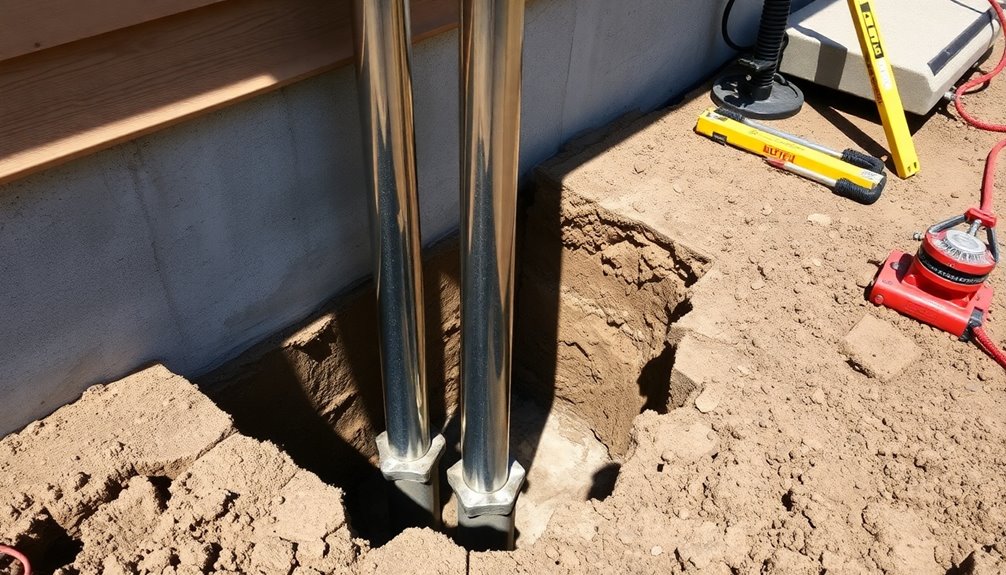
When it comes to repairing a sinking foundation, you'll find several effective methods at your disposal.
Each technique comes with its own cost considerations and suitability based on the severity of the issue.
Common Repair Techniques
Repairing a sinking foundation can involve several effective techniques tailored to the specific needs of your home.
Here are some common repair methods you might consider:
- Steel Push Piers: These are driven into load-bearing soil to stabilize and lift your structure.
- Helical Piers: Screw-shaped steel piles that are twisted into the ground, offering support in various soil conditions.
- Underpinning with Concrete Piers: Involves digging to bedrock and installing concrete piles, though it can be time-consuming and expensive.
- Mudjacking: An older technique that pumps a slurry mixture under the foundation, often seen as a temporary fix.
The average cost for these repairs typically ranges from $600 to $3,000, depending on the selected method and severity of the issue.
Cost Considerations
Understanding the costs associated with repairing a sinking foundation is crucial for homeowners facing this issue. Repair costs can vary considerably based on the severity of the signs you observe.
Typically, repairs range from $600 to $3,000 for minor issues, while more extensive methods can escalate quickly. For instance, installing steel piers may cost between $15,000 and $25,000, whereas concrete piering could set you back $20,000 to $30,000. Helical piers start around $24,000.
Foundation crack repairs can vary from $250 to $800, and leak repairs may cost between $2,300 and $7,300. Always weigh these cost considerations against the long-term benefits of maintaining a stable foundation.
Choosing the Right Method
Choosing the right method for repairing a sinking foundation can make all the difference in ensuring your home's stability and safety.
To effectively fix a sinking foundation, consider these options:
- Polyurethane Foam Injection: This non-invasive method expands to fill voids, offering a quick fix and a 5-year warranty.
- Steel or Helical Piers: These underpinning methods provide long-term stabilization by reaching stable soil, ideal for moderate to severe issues.
- Hydraulic Jacking: Suitable for mild to moderate problems, this technique can lift your home at a lower cost.
- Concrete Piering: Though effective, it's more time-consuming and expensive, often requiring deep excavation.
Always look for the signs of a sinking foundation to choose the best repair method for your situation.
Importance of Addressing a Sinking Foundation
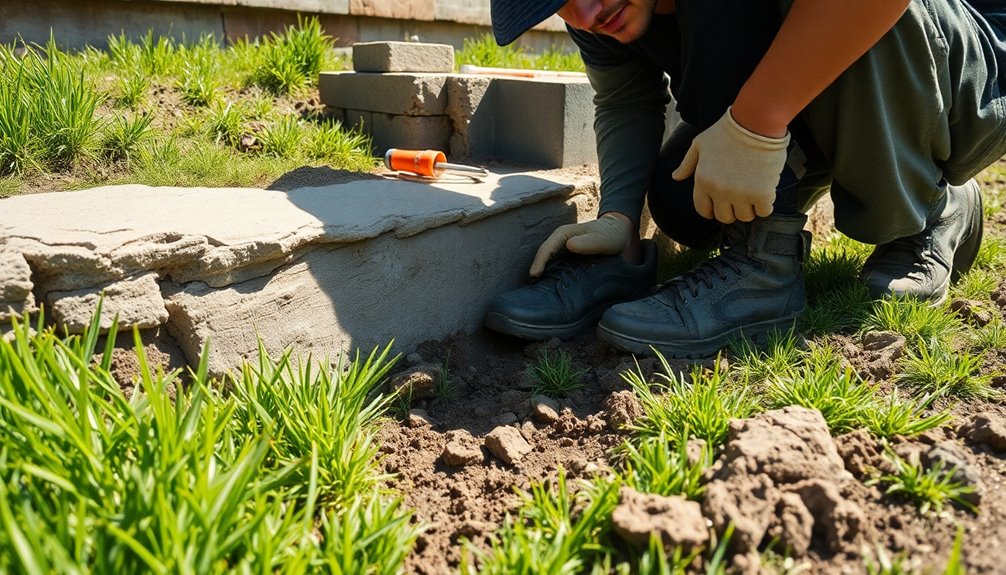
When you notice signs of a sinking foundation, such as protruding nails or sagging ceilings, it's crucial to act quickly.
Ignoring these issues can lead to significant structural damage, making it more costly and complicated to fix your foundation later.
Gaps in your existing foundation can invite moisture and pests, increasing the risk of mold growth and potential health hazards.
By addressing the problem promptly, you stabilize the foundation, maintain your property's value, and guarantee the safety of everyone inside.
Additionally, timely repairs help you comply with building codes, enhancing your home's overall aesthetics and integrity.
Professional Assistance for Foundation Repair
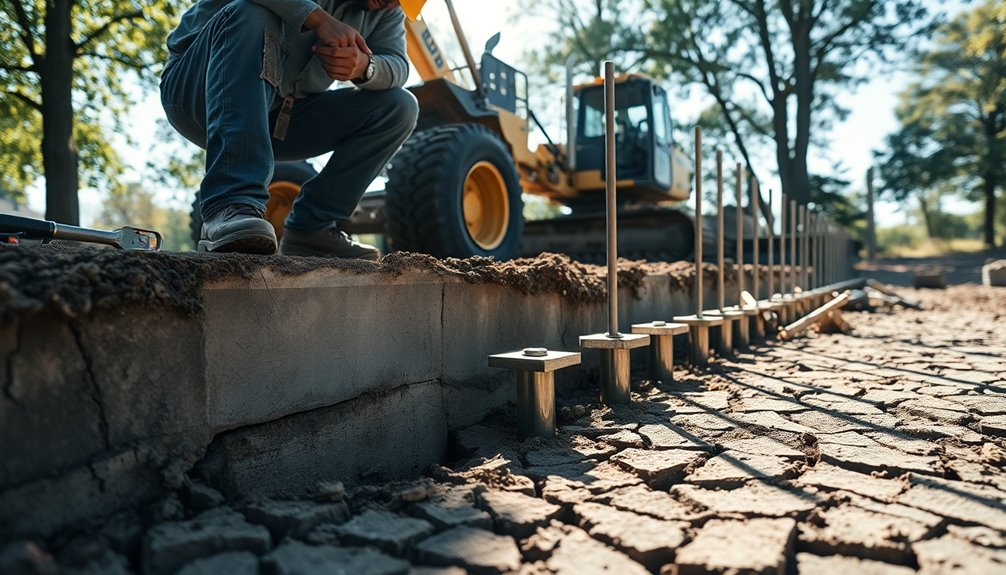
Addressing a sinking foundation promptly is essential, and enlisting professional assistance can make all the difference in ensuring a safe and stable home.
Experts conduct thorough evaluations using advanced technology to identify underlying issues.
Here are four key benefits of hiring professionals for your foundation repair:
- Expert Evaluations: Professionals assess the extent of the damage and recommend appropriate solutions.
- Advanced Techniques: They'll employ methods like helical piers or push piers for long-term stabilization.
- Local Knowledge: Experienced contractors are familiar with local building codes, ensuring compliance.
- Warranties: Reputable companies often offer warranties, giving you peace of mind about the repairs.
Professional assistance is vital to maneuvering the complexities of foundation repair and safeguarding your home.
Cost Considerations for Foundation Repairs
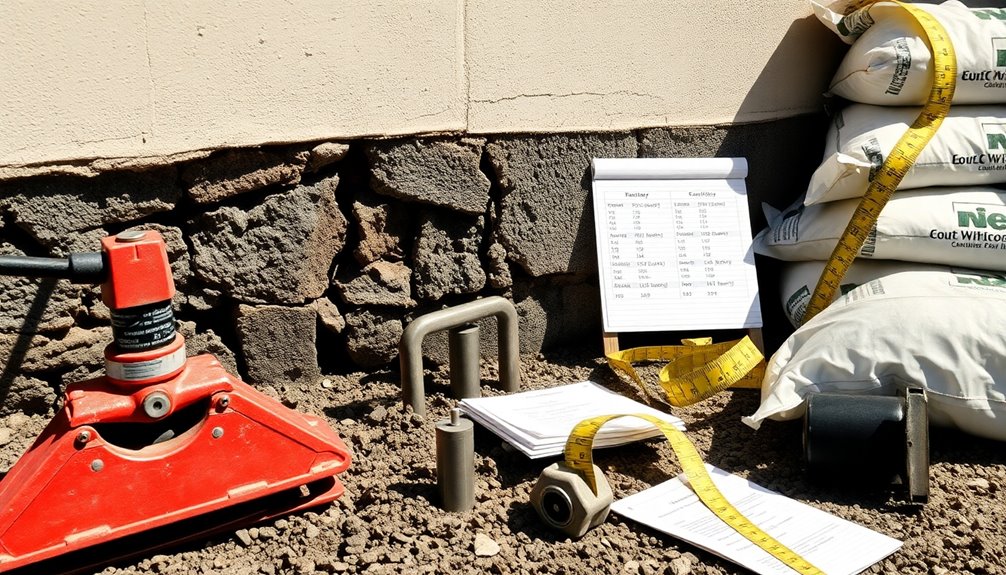
Understanding the costs associated with foundation repairs can help you make informed decisions about your home. Here's a breakdown of common cost considerations:
| Repair Type | Average Cost Range | Notes |
|---|---|---|
| Foundation Crack Repair | $250 – $800 | For minor cracks |
| Foundation Leak Repair | $2,300 – $7,300 | Extensive repairs needed |
| Steel Pier Installation | $15,000 – $25,000 | For severe damage |
| Concrete Pier Installation | $20,000 – $30,000 | Extensive excavation |
| Free Quotes | No Cost | Get tailored estimates |
It's essential to address water leaks quickly, as they can worsen foundation issues. Always consult experts to obtain tailored quotes for your specific situation.
Frequently Asked Questions
Can Sinking Foundation Be Fixed?
Yes, a sinking foundation can definitely be fixed.
You've got several options at your disposal, including underpinning, piering, and hydraulic jacking. Each method has its pros and cons, and the choice often depends on the severity of the issue.
It's essential to act quickly to avoid more extensive damage and higher costs later. Consulting a professional will help you determine the best approach and guarantee the repairs meet local standards.
How Much Does It Cost to Fix a Sinking Foundation?
So, you're wondering how much it costs to fix that lovely sinking foundation of yours?
Well, congratulations! You've just signed up for an unexpected home improvement project.
Repairs can range from a few hundred bucks for minor cracks to a whopping $25,000 if you're feeling fancy with steel piers.
It's best to nab some free quotes from local experts before you decide to sell your house instead.
Good luck!
How Do You Fix Foundation Without Lifting a House?
To fix a foundation without lifting your house, consider using methods like underpinning with push or helical piers.
These solutions stabilize your foundation by reaching deeper, load-bearing soil. You can also inject polyurethane foam to fill voids and provide support, or use mudjacking to raise sunken slabs.
Additionally, improving drainage around your home helps prevent moisture issues that contribute to sinking.
Regular maintenance is key to keeping your foundation stable and healthy.
Does Insurance Cover Sinking Foundation?
Imagine your home as a boat slowly sinking in a harbor; it's unsettling, isn't it?
When it comes to insurance covering a sinking foundation, most policies don't include it since it's seen as a maintenance issue.
However, if damage occurs from sudden events like flooding or earthquakes, you might find some coverage.
Always check your specific policy and talk to your insurance agent to explore your options and guarantee you're protected.
Conclusion
In summary, addressing a sinking foundation promptly is essential to maintaining your home's integrity and safety. For instance, imagine a family in your neighborhood that ignored warning signs, only to face costly repairs and structural damage later. By recognizing the signs early and considering professional assistance, you can save yourself from future headaches and expenses. Don't wait until it's too late—take action to secure your foundation and protect your home today.





